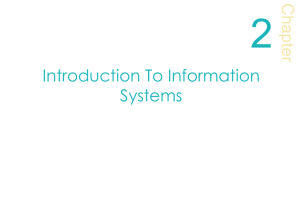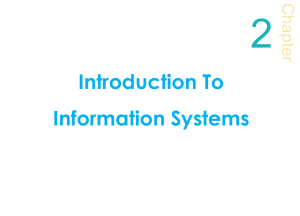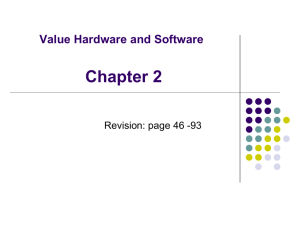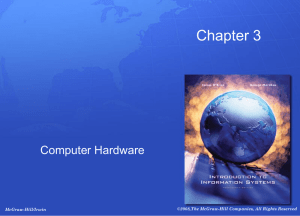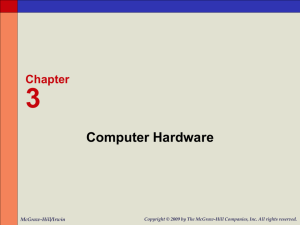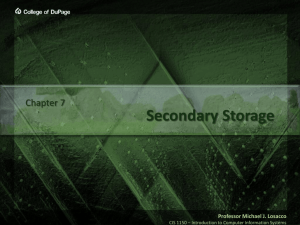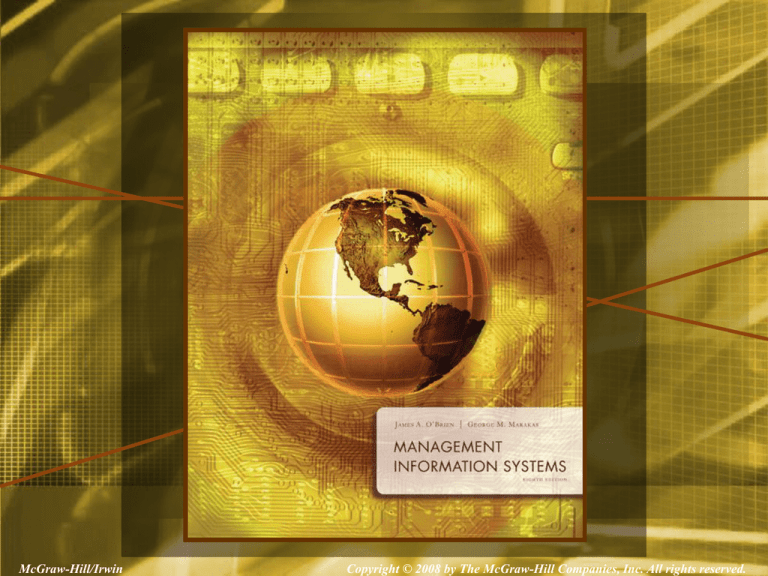
McGraw-Hill/Irwin
McGraw-Hill/Irwin
Copyright©©2008
2008,
reserved.
Copyright
by The
TheMcGraw-Hill
McGraw-HillCompanies,
Companies,Inc.
Inc.All
Allrights
rights
reserved.
Chapter
3
Computer Hardware
McGraw-Hill/Irwin
Copyright © 2008, The McGraw-Hill Companies, Inc. All rights reserved.
Learning Objectives
• Understand the history and evolution of
computer hardware
• Identify the major types and uses of
microcomputer, midrange, and mainframe
computer systems
• Outline the major technologies and uses of
computer peripherals for input, output, and
storage
3-3
Learning Objectives
• Identify and give examples of the components
and functions of a computer system
• Identify the computer systems and peripherals
you would acquire or recommend for a business
of your choice, and explain the reasons for your
selection.
3-4
Case 1: Mobile and Wireless Technology
• The challenge…
• Provide mobile computing capabilities
• Deliver applications for use on small LED
screens
• Common applications…
• Police work
• Anti-terrorism
• Global employee communication and
collaboration
3-5
Case Study Questions
• What are some of the benefits that organizations
could realize by connecting all of their
employees by mobile devices?
• Are the CIOs in the case saying that ROI is not
important when deploying mobile computing
devices?
• The case suggests that an increasingly popular
mobile device is the Black Berry. What is it
about the BlackBerry that makes it so popular?
3-6
Pre-Computer Calculations
• Counting on fingers and toes
• Stone or bead abacus
• Calculate comes from calculus, the Latin word
for stone
• 1642: first mechanical adding machine
• Invented by Blaise Pascal
• Wheels moved counters
• Modified in 1674 by Von Leibnitz
• Age of industrialization
• Mechanical loomed used punch cards
3-7
Early Computing
• 19th Century
• Charles Babbage proposed the Analytical Engine,
which could calculate, store values in memory,
perform logical comparisons
• Never built because of lack of electronics
• 1880s
• Hollerith’s punched cards used to record census
data using On/Off patterns
• The holes turned sensors On or Off when run
through tabulating machine
• This company became the foundation for IBM
3-8
Electronic Computers
• 1946 - First Generation Computer
•
•
•
•
•
ENIAC
Programmable
5000 calculations per second
Used vacuum tubes
Drawbacks were size and processing ability
• 1950s
• ENIAC replaced by UNIVAC 1, then the
IBM 704
• Calculations jumped to 100,000 per second
3-9
Waves of Computing
• Late 1950s - Second Generation
• Transistors replaced vacuum tubes
• 200,000 to 250,000 calculations per second
• Mid-1960s - Third Generation
• Integrated circuitry and miniaturization
• 1971 - Fourth Generation
• Further miniaturization
• Multiprogramming and virtual storage
• 1980s - Fifth Generation
• Millions of calculations per second
3-10
Microcomputers
• 1975
• ALTAIR flicking switches
• 1977
• Commodore and Radio Shack produce personal
computers
• 1979
• Apple computer, the fastest selling PC thus far
• 1982
• IBM introduced the PC, which changed the
market
3-11
Categories of Computer Systems
3-12
Microcomputer Systems
• Usually called a personal computer or PC
• Computing power now exceeds that of the
mainframes of previous generations
• Relatively inexpensive
• Are the networked professional workstations
used by business processions
• Versions include hand-held, notebook, laptop,
tablet, portable, desktop, and floor-standing
3-13
Recommended PC Features
Business Pro
Multimedia Heavy
Newcomer
2-3 GHz processor
Mac G4 or 2-3 GHz Intel
processor
1-2 GHz Celeron
processor
512MB RAM
512MB RAM
256MB RAM
80GB hard drive
120GB+ hard drive
40GB hard drive
18-inch flat-panel
display
18-inch or larger CRT,
flat-panel LCD, or
plasma display
17-inch CRT or 15-inch
flat panel LCD
CD-RW/DVD drive or
portable hard drives for
backup
CD-RW/DVD+RW drive
CD-RW/DVD drive
Network interface card
(NIC)
High-end color printer
Internal, 56K modem
Basic speaker system
Deluxe speaker system
Basic inkjet printer
3-14
Microcomputer Uses
• Workstations
• Supports have mathematical computer and
graphics display demands
• CAD, investment and portfolio analysis
• Network Servers
• More powerful than workstations
• Coordinates telecommunications and resource
sharing
• Supports small networks and Internet or intranet
websites
3-15
Corporate PC Criteria
• Solid performance at a reasonable price
• Operating system ready
• Connectivity
• Network interface cards
or wireless capabilities
3-16
Information Appliances
• Hand-held microcomputer devices
• Known as personal digital assistants (PDAs)
• Web-enabled PDAs use touch screens,
handwriting recognition, or keypads
• Mobile workers use to access email or the Web,
exchange data with desktop PCs or servers
• Latest entrant is the BlackBerry
• PDAs include
• Video-game consoles
• Cellular and PCS phones
• Telephone-based home email appliances
3-17
Midrange Systems
• High-end network servers that handle large-scale
processing of business applications
• Not as powerful as mainframes
• Less expensive to buy, operate, and maintain
• Often used to manage
• Large Internet websites
• Corporate intranets and extranets
• Integrated, enterprise-wide applications
• Used as front-end servers to assist mainframes
with telecommunications and networks
3-18
Mainframe Computer Systems
• Large, fast, powerful computer systems
• Large primary storage capacity
• High transaction processing
• Handles complex computations
• Widely used as superservers for…
• Large client/server networks
• High-volume Internet websites
• Becoming a popular computing platform for…
• Data mining and warehousing
• Electronic commerce applications
3-19
Supercomputer Systems
• Extremely powerful systems designed for…
• Scientific, engineering, and business applications
• Massive numeric computations
• Markets include…
• Government research agencies
• Large universities
• Major corporations
• Uses parallel processing
• Billions to trillions of operations per second
(gigaflops and teraflops)
• Costs $5 to $50 million
3-20
Computer System Concept
• A system of hardware devices organized by
function
• Input
• Keyboards, touch screens, pens, electronic mice,
optical scanners
• Converts data into electronic form for entry into
computer system
• Processing
• Central Processing Unit (CPU)
• CPU subunits: arithmetic-logic and control unit
3-21
Computer System Concept
• Output
• Video display units, printers, audio response units,
and so on
• Converts electronic information into humanintelligible form
• Storage
• Primary storage (memory)
• Secondary storage (disk drives)
• Control
• CPU controls other components of the system
3-22
Computer System Concept
3-23
Computer Processing Speeds
• Early computers
• Milliseconds (thousandths of a second)
• Microseconds (millionths of a second)
• Current computers
• Nanoseconds (billionth of a second)
• Picoseconds (trillionth of a second)
• Program instruction processing speeds
• Megahertz (millions of cycles per second)
• Gigahertz (billions of cycles per second)
• Commonly called the “clock speed”
3-24
Computer Processing Speeds
• Throughput
• The ability to perform useful computation or data
processing assignments during a given period
• Speed is dependant on…
• Size of circuitry paths (buses) that interconnect
microprocessor components
• Capacity of instruction processing registers
• Use of high-speed cache memory
• Use of specialized microprocessor, such as math
coprocessor
3-25
Moore’s Law
• A doubling in the number of transistors per
integrated circuit every 18 to 24 months
• Originally observed in 1965, it holds true today
• Common corollary of Moore’s Law…
• Computing prices will be cut in half every 18 to
24 months
• This has been consistently accurate
• Applies to cost of storage as well
3-26
Moore’s Law
3-27
Case 2: Apple Computer
• Apple dropped from market leader to niche
player due to…
• Closed systems with proprietary hardware and
software
• Incompatibility with PC applications
• Competition from Microsoft’s Windows OS,
which was mass-marketing to PC manufacturers
• Also a closed system, iPod has most of market
• Struck copy-protection agreements with music
companies
3-28
Case Study Questions
• Do you agree that Apple will dominate the
digital music market for years to come?
• Can the technology and business strategies Steve
Jobs implemented with the closed system of the
iPod be applied successfully to the iMac and
other Apple closed-system computer products?
• Will the cachet of the iPod and the capabilities of
Boot Camp and the Leopard version of Apple’s
OS X lure more Windows PC users to the Mac
lineup of desktops and portables?
3-29
Peripherals
• Peripheral is a generic name for all input,
output, and secondary storage devices
• Parts of the computer system, but not the CPU
• Are all online devices
• Online devices
• Separate from the CPU, but electronically
connected to and controlled by it
• Offline devices
• Separate from and not under the control of the
CPU
3-30
Peripherals Advice
3-31
Input Technologies
• Keyboard
• Still most widely used input device
• Graphical User Interface (GUI)
• Icons, menus, windows, buttons, bars
• Selected with pointing devices
• Electronic Mouse
• Most popular pointing device
• Pressing mouse buttons initiates
activity represented by the icon
selected
3-32
Input Technologies
• Trackball
• Stationary device, similar to mouse
• Roller ball moves cursor on screen
• Pointing Stick
• Small eraser-head device
embedded in keyboard
• Cursor moves in the
direction of the pressure
placed on the stick
3-33
Input Technologies
• Touchpad
• Small, rectangular, touch-sensitive surface
• Usually on keyboard
• Cursor moves in direction your finger moves
• Touch Screen
• Use computer by touching
screen
• Screen emits a grid of
infrared beams, sound waves,
or electric current
• Grid is broken when screen is touched
3-34
Pen-Based Computing
• Used in Tablet PCs and PDAs
• Pressure-sensitive layer, similar
to touch screen, under liquid
crystal display screen
• Software digitizes handwriting,
hand printing, and hand drawing
3-35
Speech Recognition Systems
• Speech be the future of data entry
• Easiest, most natural means of human
communication
• Recognizing speech patterns
• Discrete required pauses between each word
• Continuous speech recognition software (CSR)
recognized continuous, conversationally paced
speech
3-36
Speech Recognition Software
• Speech recognition systems digitize, analyze,
and classify speech and sound patterns
• Compares to a database of sound patterns in its
vocabulary
• Passes recognized words to the application
software
• Typically requires voice recognition training
• Speaker-independent voice recognition systems
• Allows computer to recognize words from a voice
it has never heard before
• Typically used in voice-messaging computers
3-37
Optical Scanning
• Devices read text or graphics and convert them
into digital input for a computers
• Enables direct entry of data from source
documents
• A document management library system
• Scans documents, then organizes and stores them
for easy reference or retrieval
3-38
Optical Scanning
• Scanners
• Compact desktop models are popular for low
cost and ease of use
• Larger, more expensive flatbed scanners are faster
and provide high-resolution color scanning
• Optical Character Recognition (OCR)
• Software that reads characters and codes
• Used to real merchandise tags, sort mail,
score tests
• Optical scanning wands read bar codes
3-39
Other Input Technologies
• Magnetic Stripe
• Reads the magnetic stripe on credit cards
• Smart Cards
• Microprocessor chip and memory on credit card
• Use more in Europe than in the U.S.
• Digital Cameras
• Allows you to shoot, store, and download photos
or full-motion video with audio into the PC
• Images and audio can then be edited or enhanced
3-40
Other Input Technologies
• Magnetic Ink Character Recognition (MICR)
• Used by banks to magnetically read checks and
deposit slips
• Requires an iron oxide-based ink
• Reader-sorter equipment magnetizes the ink, then
passes it under a reading head to sense the signal
3-41
Output Technologies
• Video Displays
• Cathode-ray tube (CRT)
• Liquid crystal displays (LCDs)
• Active matrix and dual scan
• Plasma displays
• Used in large TVs and flat-panel monitors
• Printed Output
• Inkjet printers spray ink on a page
• Laser printers use an electrostatic process similar
to a photocopying machine
3-42
Storage Tradeoffs
3-43
Computer Storage Fundamentals
• Uses a two-state or binary representation of data
• On or Off
• On represents the number 1
• Off represents the number 0
• Data are processed and stored in computer
systems through the presence or absence of
On/Off signals
3-44
Bit and Byte
• Bit
• Short for binary digit
• Smallest element of data
• Either zero or one
• Byte
• Group of eight bits, which operate as a single unit
• Represents one character or number
3-45
Representing Characters in Bytes
3-46
Using Binary Code to Calculate
3-47
Storage Capacity Measurement
•
•
•
•
•
Kilobyte (KB): one thousand bytes
Megabyte (MB): one million bytes
Gigabyte (GB): one billions bytes
Terabyte (TB): one trillion bytes
Petabyte (PB): one quadrillion bytes
3-48
Direct and Sequential Access
• Direct or Random Access
• Directly store and retrieve data
• Each storage position has a unique address and
can be accessed in the same length of time
• Semiconductor memory chips, magnetic disks
• Sequential Access
• Data is stored and retrieved sequentially
• Must be accessed in sequence by searching
through prior data
• Magnetic tape
3-49
Direct and Sequential Access
3-50
Semiconductor Memory
• Microelectronic semiconductor memory chips
are used for primary storage
• Advantages: small size, fast, shock and
temperature resistance
• Disadvantages: volatility; must have
uninterrupted electric power or loses memory
3-51
Types of Semiconductor Memory
• Random Access Memory (RAM)
• Most widely used primary storage medium
• Volatile memory
• Read/write memory
• Read-Only Memory (ROM)
• Permanent storage
• Can be read, but not overwritten
• Frequently used programs burnt into chips during
manufacturing process
• Called firmware
3-52
Flash Drives
• Sometimes referred to as a jump drive
• Uses a small chips containing
thousands of transistors
• Can store data for virtually
unlimited periods without power
• Easily transported and highly
durable
• Storage capacity of up to 1 GB
• Plugs into any USB port
3-53
Magnetic Disks
• Used for secondary storage
• Fast access and high capacity
• Reasonable cost
3-54
Types of Magnetic Disks
• Floppy Disks (diskettes)
• Magnetic disk inside a plastic jacket
• Hard Disk Drives (hard drives)
• Magnetic disk, access arms, and read/write heads
in sealed module for stable environment
• Fixed or removable
• Capacity from several hundred MBs to
hundreds of GBs
3-55
RAID Storage
• Redundant Arrays of Independent Disks
• Disk arrays of hard disk drives
• Provides virtually unlimited online storage
• Combines from 6 to more than 100 small hard
disk drives into a single unit
• Data are accessed in parallel over multiple paths
from many disks
• Redundant storage of data on several disks
provides fault-tolerant capacity
• Storage area networks can interconnect many
RAID units
3-56
Magnetic Tape
• Secondary storage
•
•
•
•
Tape reels, cassettes, and cartridges
Used in robotic, automated drive assemblies
Archival and backup storage
Lower-cost storage solution
3-57
Optical Disks
3-58
Uses of Optical Disks
• Image processing
• Long-term storage of historical image files
• Storage of scanned documents
• Publishing medium
• Allows fast access to reference materials
• Catalogs, directories, and so on
• Interactive multimedia applications
• Video games, educational videos, and so on
3-59
Radio Frequency Identification (RFID)
• One of the newest and fastest growing storage
technologies
• System for tagging and identifying mobile objects
• Used with store merchandise, postal packages,
casino chips, pets
• Special reader allows objects to be tracked as
they move from place to place
• Chips half the size of a grain of sand
• Passive chips derive power from reader signal
• Active chips are self-powered
3-60
RFID Versus Bar Coding
• RFID
• Scans from greater distance
• Can store data
• Allows more information to be tracked
• Privacy concerns
• Invisible nature of the system
• Capacity to transmit fairly sophisticated messages
3-61
Case 3: Self-Service Kiosks
• Self-service kiosks at airports
• More than half of Northwest Airline’s eligible
customers choose self-service check-in
• Kiosks shave 5 to 15 minutes off the time Delta
customers stand in line
• Cost savings are massive
• Vancouver Airport would need 145 additional
check-in counters without the kiosks
3-62
Self-Service Kiosk Technology
• Networked special-purpose microcomputer
terminals
• Video touch screens
• Built-in thermal printers
• Magnetic-stripe card readers
3-63
Case Study Questions
• What computer system technologies and
functions are included in self-service kiosks?
• What other technologies should be provided?
• What is the customer value of self-service kiosks
for airline check-ins?
• What other services should be provided?
• What is the business value of self-service kiosks
in the airline industry?
• Do self-service kiosks give airlines a competitive
advantage?
3-64
Case 4: Advances in Speech Recognition
• Computerized speech has become…
• Smarter
• Easier to use
• More integrated with other applications
• Interactive Voice Response (IVR)
• Early systems were menu-driven
• Advanced are more conversational
• Are now connected to other systems
3-65
Case Study Questions
• What are the business benefits and limitations of
IVR at Verizon and others?
• How could their use of IVR be improved?
• What types of business situations would benefit
most from IVR technology?
• Which would benefit the least?
• Given the advancement in voice recognition
software over the last 20 years, what types of
new applications of IVR do you see in the next
20 years?
3-66

